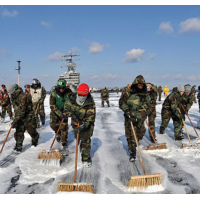U.S. Sailors Fight for Day in Court to Press $1 Billion Suit over Contamination at Fukushima
 Washdown on USS Ronald Reagan after Fukushima disaster
Washdown on USS Ronald Reagan after Fukushima disaster
It's been two months since lawyers refiled a lawsuit on behalf of U.S. sailors who claim they were made sick during a rescue mission to Fukushima, Japan, in 2011, and so far this one hasn't been tossed by the judge.
Seventy-nine sailors aboard the San Diego-based USS Ronald Reagan filed a $1 billion federal class-action lawsuit (pdf) against Tokyo Electric Power Company (TEPCO) for injuries they sustained when the aircraft carrier rushed to assist survivors after an earthquake-induced tsunami knocked out the Fukushima nuclear power plant operated by the utility. The ship had 5,500 sailors on board.
The suit alleges that TEPCO lied about conditions around the plant in March 2011, leading to the sailors being dosed with dangerous levels of radiation for an extended period of time. A similar suit filed in 2012 was thrown out of court by a judge who said it improperly named the Japanese government, which is the plant owner, as a defendant. The judge said the sailors couldn't sue a sovereign government.
U.S. military personnel are also legally barred from suing their own government.
TEPCO defended itself by saying it was the U.S. military's fault for believing the utility's press releases and public pronouncements about how safe the area was:
“It is wholly implausible—absent some additional facts that the (complaint) does not (and cannot) allege—to posit that military commanders in charge of thousands of personnel and armed with some of the world’s most sophisticated equipment, relied instead only on the press releases and public statements of a foreign electric utility company.”
It is, of course, wholly plausible that the military was stupid enough to believe the Japanese pronouncements. But a damning report, “Mobilizing Nuclear Bias: The Fukushima Nuclear Crisis and the Politics of Uncertainty,” published in February in the journal Japan Focus documented Navy communications that showed the level of contamination was well known even as the USS Reagan steamed into the danger zone.
After the ship arrived, while the plant was still belching radioactivity into the atmosphere and poisoning the water, sailors were drenched in a warm cloud of radioactive fallout—it had a “metallic taste”—and then ordered to scrub the radioactive materials off the super-carrier’s deck while dressed in fatigues, hoodies and zero protection.
Some sailors jumped in the water to rescue victims and all of them drank radioactive water that had been processed by the ship's desalinization system. Once the military realized the sailors had been dosed, the ship headed for nearby ports but no Pacific Rim country, including Japan, would let them dock. They stayed at sea for two months before heading home.
The Navy insists that the radiation contamination wasn't too bad. A statement from Navy spokesman Lt. Greg D. Raelson said, “There is no indication that any U.S. personnel supporting Operation Tomodachi experienced radiation exposure at levels associated with the occurrence of long-term health effects. . . . For perspective, the worst-case radiation exposure for a crew member on USS Ronald Reagan is less than 25 percent of the annual radiation exposure to a member of the U.S. public from natural sources of background radiation, such as the sun, rocks and soil.”
Suffering sailors beg to disagree. The lawsuit contends, “In the three years since, dozens have developed cancers, at least one has borne a child with birth defects, and all “must now endure a lifetime of radiation poisoning and suffering which could have and should have been avoided.” Ailments include, “leukemia, ulcers, gall bladder removals, brain cancer, testicular cancer, dysfunctional uterine bleeding, thyroid illnesses, stomach ailments and a host of other complaints unusual in such young adults.”
California environmental law expert Paul Garner, attorney for the plaintiffs, said that about one-third of the sailors are still on active duty.
Fukushima is still a dangerous hot spot with three of the four melting nuclear cores still unaccounted for and thousands of dangerous radioactive rods scattered about.
‒Ken Broder
To Learn More:
Fukushima’s Tepco Slapped with US$1B Lawsuit by 79 US Sailors Over Radiation Claims (by Esther Tanquintic-Misa, International Business Times)
Reagan Sailors Press on in Radiation Lawsuit (by Meghann Myers, Navy Times)
Lawsuit: Fukushima Disaster Poisoned U.S. Sailors (by Teri Sforza, Orange County Register)
USS Reagan Sailors File $1 Billion Suit over Radiation Exposure (by Beth Ford Roth, KPBS)
8 U.S. Sailors Stationed in San Diego Sue Japanese for Lying about Radiation at Fukushima Plant (by Noel Brinkerhoff and David Wallechinsky, AllGov California)
Lindsay R. Cooper et al v. Tokyo Electric Power Company (U.S. District Court for the Southern District of California San Diego Division) (pdf)
- Top Stories
- Controversies
- Where is the Money Going?
- California and the Nation
- Appointments and Resignations
- Unusual News
- Latest News
- California Forbids U.S. Immigration Agents from Pretending to be Police
- California Lawmakers Urged to Strip “Self-Dealing” Tax Board of Its Duties
- Big Oil’s Grip on California
- Santa Cruz Police See Homeland Security Betrayal in Use of Gang Roundup as Cover for Immigration Raid
- Oil Companies Face Deadline to Stop Polluting California Groundwater





